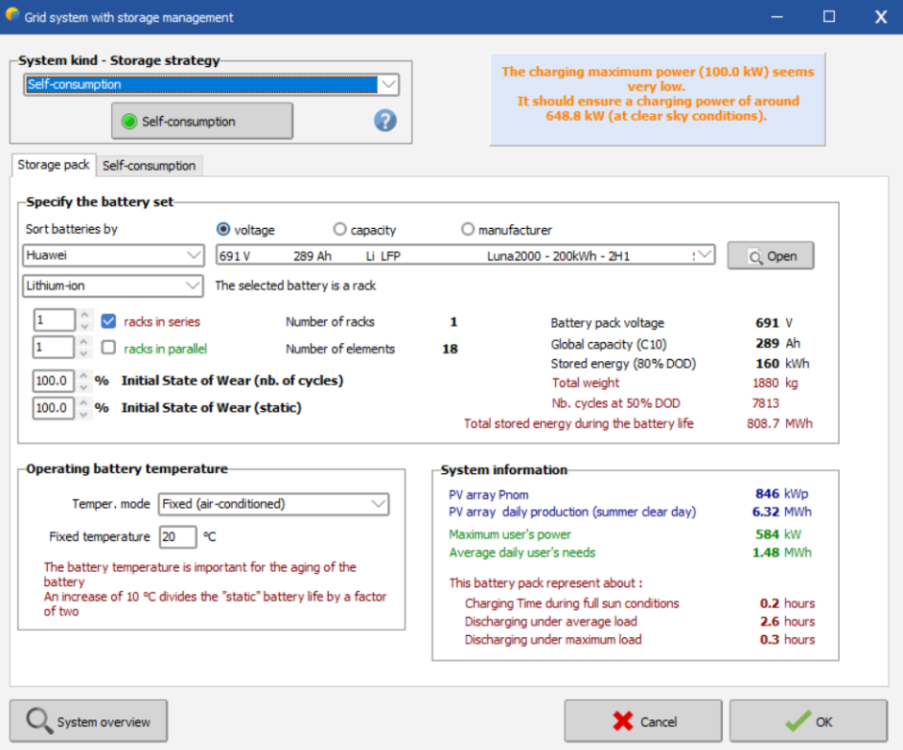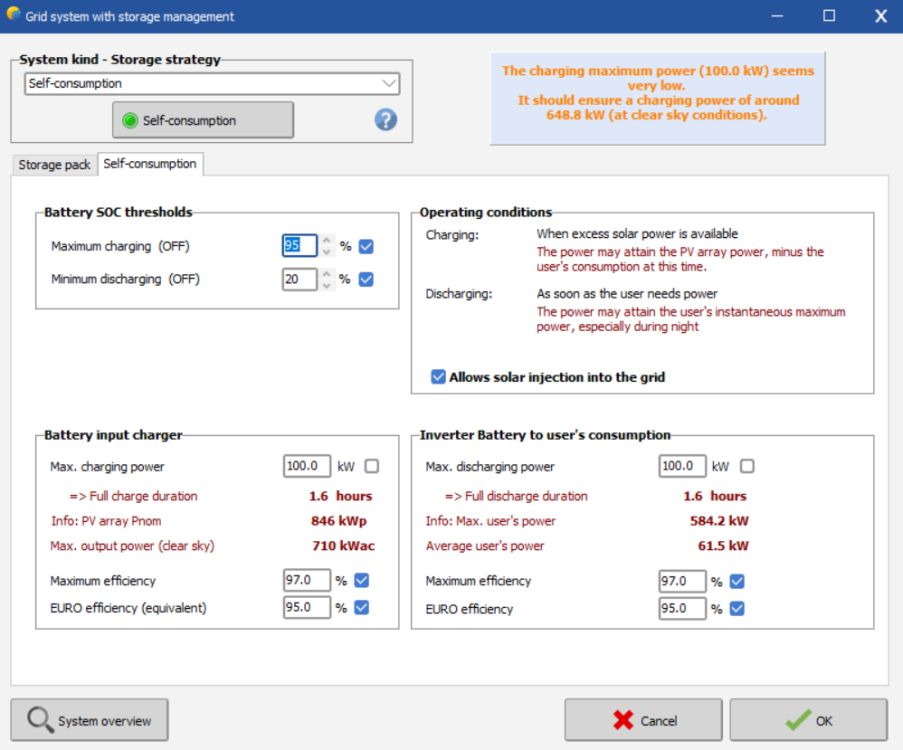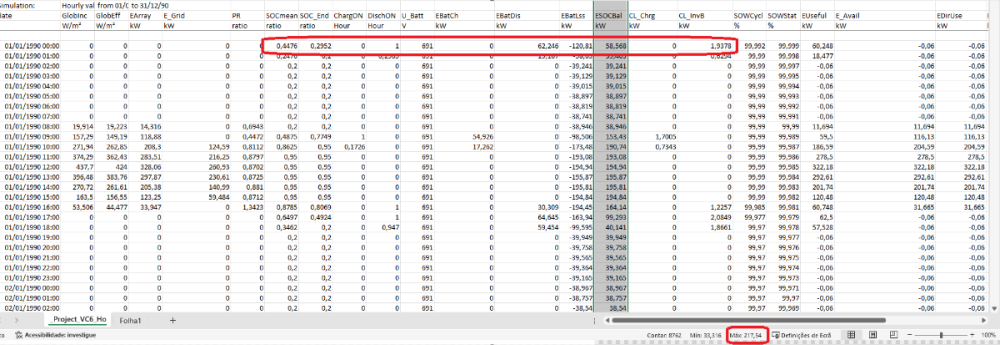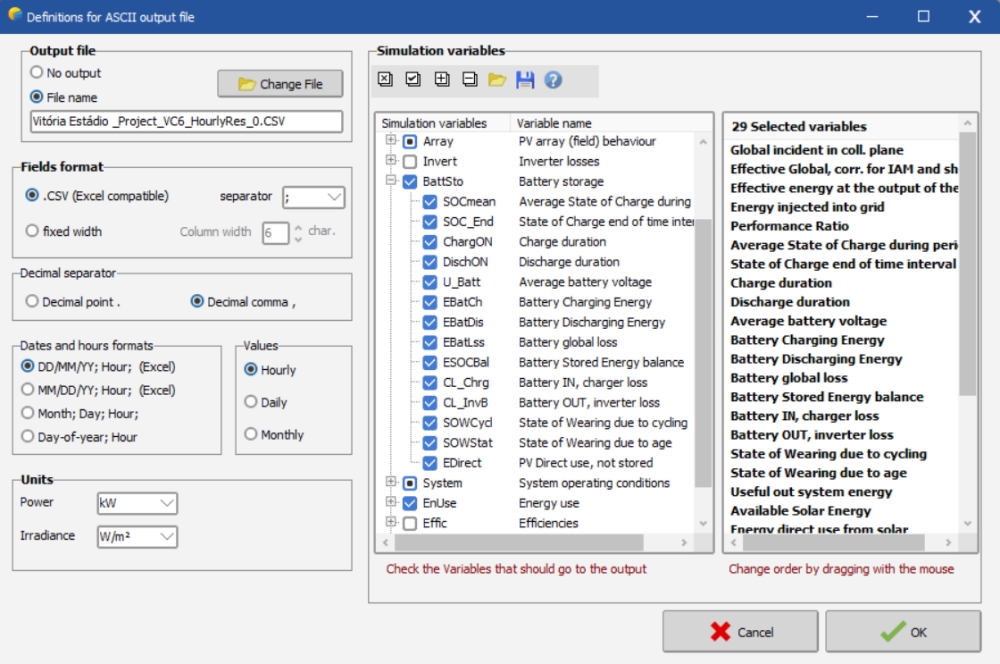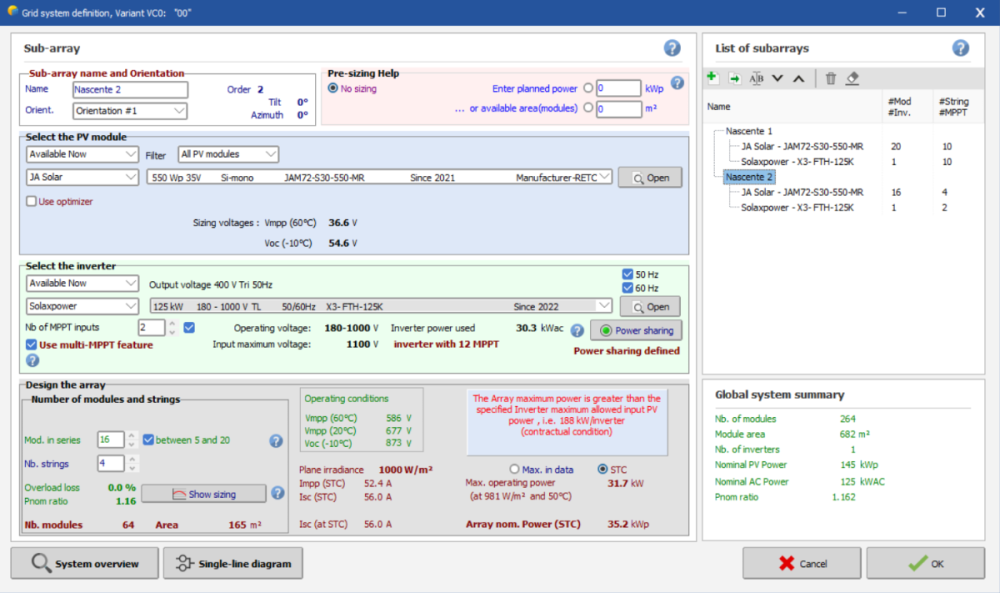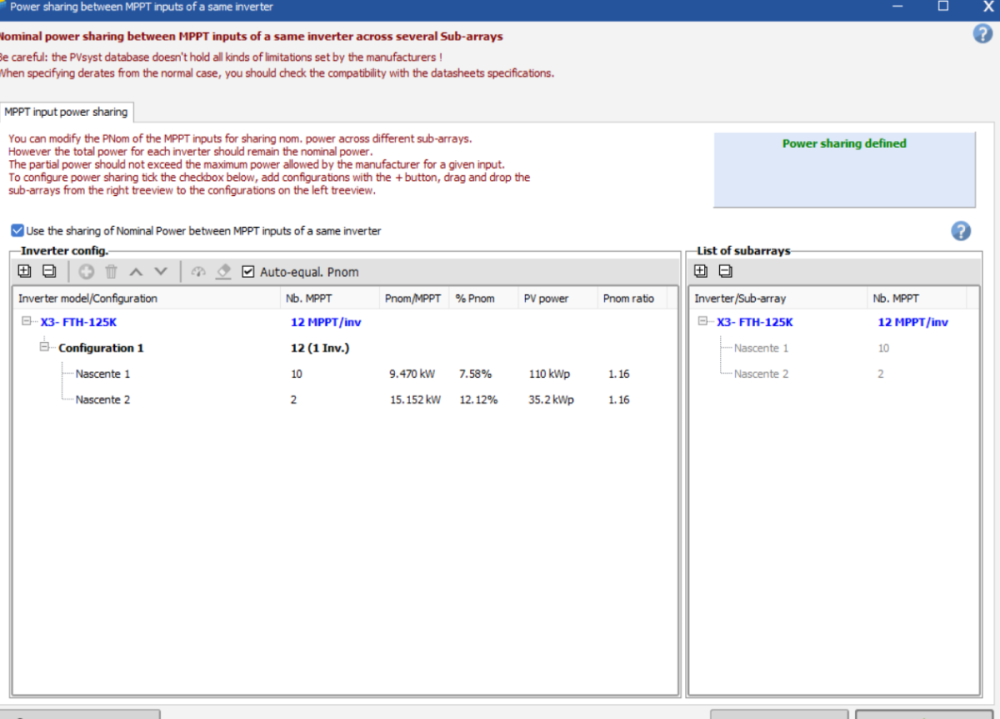
joao.ferreira
Members-
Posts
7 -
Joined
-
Last visited
Everything posted by joao.ferreira
-
Thank you so much for your answers André. I'll be waiting for the next version aswell. Best regards.
-
This battery file is an external file, provided by the manufacter. This print is the same from my 2nd message in this thread. If you check the warning in the top right corner you can see that I had already defined the 100 kW charge/discharge in the beginning of this thread and it was for this simulation that I got those strange values for ESOCBal. I understand that I was getting this warning because the system didn't have the optimal size for my PV and profile consumption (this disappeared when I considered 5 of these in parallel with 1000 kWh capacity and 500 kW charge/discharge power). I believe that what is causing the confusion is the system information box in the down right box. The information in "This battery pack represent about:" stays the same whatever the charge/discharge power defined in the next page. This values only depend on the consumption profile, the PV System and the battery capacity, regardless of the power for charging/discharging. I have now made a simulation for a storage system with 5 of these in parallel giving a total of 1000 kWh capacity and 500 kW charge/discharge. As you can see, the ESOCBal maximum value for a single hour is 1088,5 kWh (so, similar to the results I had previously with the 200 kWh system where the maximum value for this variable was around 217 kWh). The max value for EBatDis was 505,48 kWh which is a little bit above the 500 kW charge/discharge that I had defined, but still acceptable I guess. Thank you so much once again for your answers to my questions.
-
Thank you so much for your answers so far. I understand that the system that I'm using isn't the optimal size, and I'm really sorry, but i don't understand why you tell me is absurd or unrealistic. I am using a BTR. file developed by the manufacter (Huawei). It's a smart string ESS with 200 kWh (160 kWh is at 80% DOD) of capacity and 100 kW rated power. I believe I've defined the system correctly, please tell if I'm totally wrong. This is the page of self-consumption defined at the start of my simulation with 100 kW maximum charge and discharge power, as per datasheet. Again, I understand that this storage system isn't the optimal size, I pretend to considerer up to 5 of these in parallel (maximum allowed by Huawei). But I really don't understand, in terms of simulation, what is the problem of making an evaluation of the economic/energy balance for a system with 846 kWp of PV and a storage system with only 200 kWh and 100 kW charge/discharge. Although it is not optimal, you may not want to make the full investment, or simply to know what results you get with considering only 1 of these ESS. Why is it different, in terms of how PVSyst handles the data and the simulation, of having 200 kWh and 100 kW charge/discharge, and having 1000 kWh and 500 kW charge/discharge? Once again, thank you so much for your explanations and patience so far, I'm just trying to understand what I'm doing wrong.
-
Thank you for the update André, I know it was undersized, was just trying to get familiar with the variables and the use of storage in simulations before actually finding the best size for the system.
-
1- This is the battery that I'm using the simulations. For this case, I'm only using one battery, so I should have a maximum capacity of around 200 kWh at 100% DOC. When I go through my results in the hourly output file I get for the ESOCBal a maximum value of 217 kWh, which is higher thant the 200 kWh maximum capacity, and I have defined a maximum of 95% DOC. Also, the maximum charging power is 100 kW, so I don't know how can I get that value for a single time interval. If we look in the first line of the simulation as an example, if it represents the balance between the start and end for that time period, shouldn't it have the same value as EBatDis? 2- I was asking if we can have the SOC at the start of each time interval for every hourly value of the simulation, not the start of the simulation since this value is kinda irrelavant. I can only find SOC mean and SOC at the end of the time interval. 4- I could be wrong but I just wanted to test results when there are electricity prices defined for the simulation, and the PV array power for that day was not enough to charge the battery , you could charge it at lower prices to have it available when the prices get to their peak for that day. In the simulation this will only happen in lower production days when the storage system is oversized vs PV. I believe PVSyst doesn't consider days without PV production due to having a cloudy day without sun, but in a real case scenario this might happen, which this strategy could make up for. Thank you for your answers.
-
Hi, I'm trying to include storage with self consumption, but having some difficulties understanding the variables presented. 1- Does ESOCBal represent how much energy, in kWh, is stored in the battery at the end of the period? I know that SOC_END is the SOC (ratio) at the end of that period, but for the ESOCBal I'm seeing values greater than the battery capacity at the DOC defined and lower values than the DOD defined. 2- Also, I've seen in some threads that the SOC_BEG, or the SOC at the beggining of the time interval is available, but I can't seem to find them in the simulation variables. 3- For the energy discharged from the battery that feeds the load, can we do EBatDis-CL_InvB? 4- Lastly, is it possible to charge the battery from the grid when the PV array doesn't charge it, so that we have full cycles each day? Sorry for making more than 1 question on the same thread, and thank you in advance.
-
Some inverter manufacturers have contractual conditions on PVSyst OND files regarding Maximum PV Power and Maximum PV Current allowed. In a particular case, when trying to use the power sharing function, and having 12 available MPPT and 14 strings, 2 of these MPPT have to share 2 strings each. Although my total PV array (145 Wp) is below the inverter manufacturer limit (188 kWp as seen in error message below), i still get this error message. I'm assuming this is happening due to PVSyst considering that the inverter can only handle 188/12 of array power per MPPT, even if other MPPT's are more relieved. Although power sharing is available for this inverter model, it still triggers the error message. Does this mean that the chosen inverter can't handle such array power per MPPT, even though it respects the Isc and Voc limitations defined by the manufacturer in their datasheets?

